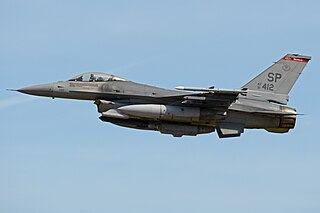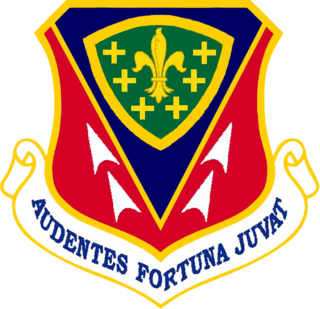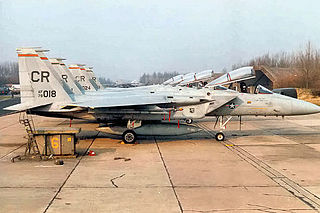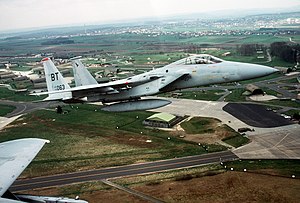
Spangdahlem Air Base is a NATO air base with the United States Air Force as a tenant constructed between 1951 and 1953 and located near the small German town of Spangdahlem, approximately 30 kilometres (19 mi) north-northeast of the city of Trier, Rhineland-Palatinate.

The 527th Space Aggressor Squadron is a United States Space Force unit assigned to the Space Training and Readiness Command. The unit traces its lineage to the 312th Bombardment Squadron (Light) constituted in 1942. It presents realistic adversary threats to US and allied military forces to improve their training for space-associated operations. It is stationed at Schriever Space Force Base, Colorado. Its present form dates from its activation as part of the United States Air Force in 2000. That year it was activated as part of the Space Warfare Centre, but it was then transferred to the 57th Adversary Tactics Group in 2006. With the formation of the Space Force in 2019, the squadron was part of the second wave of transfers and reorganizations which took place in mid-2020.

Quartier La Horie is a French Army base. It is located in the Moselle département, about 2 miles(3 km) west of the town of Phalsbourg, on the north side of the Route nationale 4 (N4) Highway adjacent to the village Saint-Jean-Kourtzerode; 29 miles (47 km) northwest of Strasbourg.

The United States Air Force's 36th Wing is the host wing for Andersen Air Force Base, Guam. It is part of Pacific Air Forces' Eleventh Air Force. The 36th Wing provides day-to-day mission support to more than 9,000 military, civilian, dependent and retired personnel and 15 associate units on the base.

Fürstenfeldbruck Air Base is a former German Air Force airfield near the town of Fürstenfeldbruck in Bavaria, near Munich, Germany.

The 366th Fighter Wing is a fighter wing of the United States Air Force Air Combat Command stationed at Mountain Home Air Force Base, Idaho.

The Seventeenth Expeditionary Air Force was a numbered air force of the United States Air Force located at Ramstein Air Base, Germany. The command served the United States Air Forces in Europe during (1953–1996) and United States Air Forces Africa during 2008–2012. Upon reactivation on 1 October 2008, it became the air and space component of United States Africa Command. In this capacity, Seventeenth Air Force was referred to as U.S. Air Forces Africa (AFAFRICA). 17 AF was reformed in April 2012 to become the 17th Expeditionary Air Force, sharing a commander and headquarters with the Third Air Force. As of March 2022, the Third Air Force is USAFE-AFAFRICA's sole numbered air force, with the 17 EAF having been inactivated in July 2018.

The 52nd Fighter Wing is a wing of the United States Air Force stationed at Spangdahlem Air Base, Germany. It flies the F-16CJ fighter aircraft. It was activated in 1948, but derives significant elements of its history from the predecessor Second World War 52nd Fighter Group, which is now the 52nd Operations Group, subordinate to the wing.

The 9th Attack Squadron is a United States Air Force squadron, assigned to the 49th Operations Group, stationed at Holloman Air Force Base, New Mexico. The squadron is a training unit for new pilots and sensor operators for the MQ-9 Reaper Remotely Piloted Aircraft (RPA).

The 23d Fighter Squadron is an inactive United States Air Force unit. It was last assigned to the 52d Operations Group and stationed at Spangdahlem Air Base, Germany. It was inactivated on 13 August 2010.

The 131st Fighter Squadron is a unit of the Massachusetts Air National Guard 104th Fighter Wing located at Barnes Air National Guard Base, Westfield, Massachusetts. The 131st is equipped with the F-15C/D Eagle.

The 53rd Fighter Squadron is an active unit of the United States Air Force, stationed at Joint Base Andrews, Maryland. Assigned to the 495th Fighter Group, the squadron was last activated on 10 December 2021, as an associate unit to the 113th Wing's 121st Fighter Squadron. It was previously assigned to the 52nd Operations Group and stationed at Spangdahlem Air Base, Germany, from where it operated the McDonnell Douglas F-15C/D Eagle until its inactivation on 31 March 1999.

The 81st Fighter Squadron is an inactive squadron of the United States Air Force. It was last assigned to Air Education and Training Command, stationed at Moody Air Force Base, Georgia as a geographically separate unit of the 14th Operations Group, 14th Flying Training Wing at Columbus Air Force Base, Mississippi. The squadron last operated the A-29B Super Tucano aircraft, conducting close air support training for allied nations.

The 7th Fighter Squadron is an active United States Air Force unit, assigned to the 1st Operations Group. It is stationed at Langley Air Force Base, Virginia.

The 525th Fighter Squadron is a United States Air Force unit. It is assigned to the 3d Operations Group at Joint Base Elmendorf–Richardson, Alaska. The squadron was first activated as the 309th Bombardment Squadron in February 1942. After training in the United States, it deployed to the Mediterranean Theater of Operations, where it became the 525th Fighter-Bomber Squadron and engaged in combat until the spring of 1945, earning two Distinguished Unit Citations. After VE Day, the squadron became part of the occupation forces in Germany. Briefly inactivated in 1946, it returned to Germany a few months later.

The 32nd Air Operations Squadron, nicknamed the Wolfhounds, is an inactive United States Air Force unit. Its last assignment was with 32nd Air Operations Group, based at Ramstein Air Base, Germany. It was inactivated on 1 November 2005. Between 1955 and 1994, the unit was based at Soesterberg Air Base in the Netherlands, providing air defence on behalf of NATO as a fighter squadron.

The 52d Operations Group is the flying component of the 52d Fighter Wing, assigned to the United States Air Forces in Europe - Air Forces Africa (USAFE-AFAFRICA). The group is stationed at Spangdahlem Air Base, Germany.

The 388th Operations Group is the flying component of the 388th Fighter Wing, assigned to the Air Combat Command Twelfth Air Force. The group is stationed at Hill Air Force Base, Utah.

The 36th Operations Group is the operational component of the 36th Wing, assigned to the United States Air Force Pacific Air Forces. The group is stationed at Andersen Air Force Base, Guam.

The 480th Fighter Squadron, nicknamed the "Warhawks", is an active United States Air Force unit operating the General Dynamics F-16CJ Fighting Falcon. The 480 FS assigned to the 52nd Fighter Wing, Spangdahlem Air Base, Germany is the only United States Air Forces in Europe – Air Forces Africa flying unit performing the Suppression of Enemy Air Defenses (SEAD) mission.
































